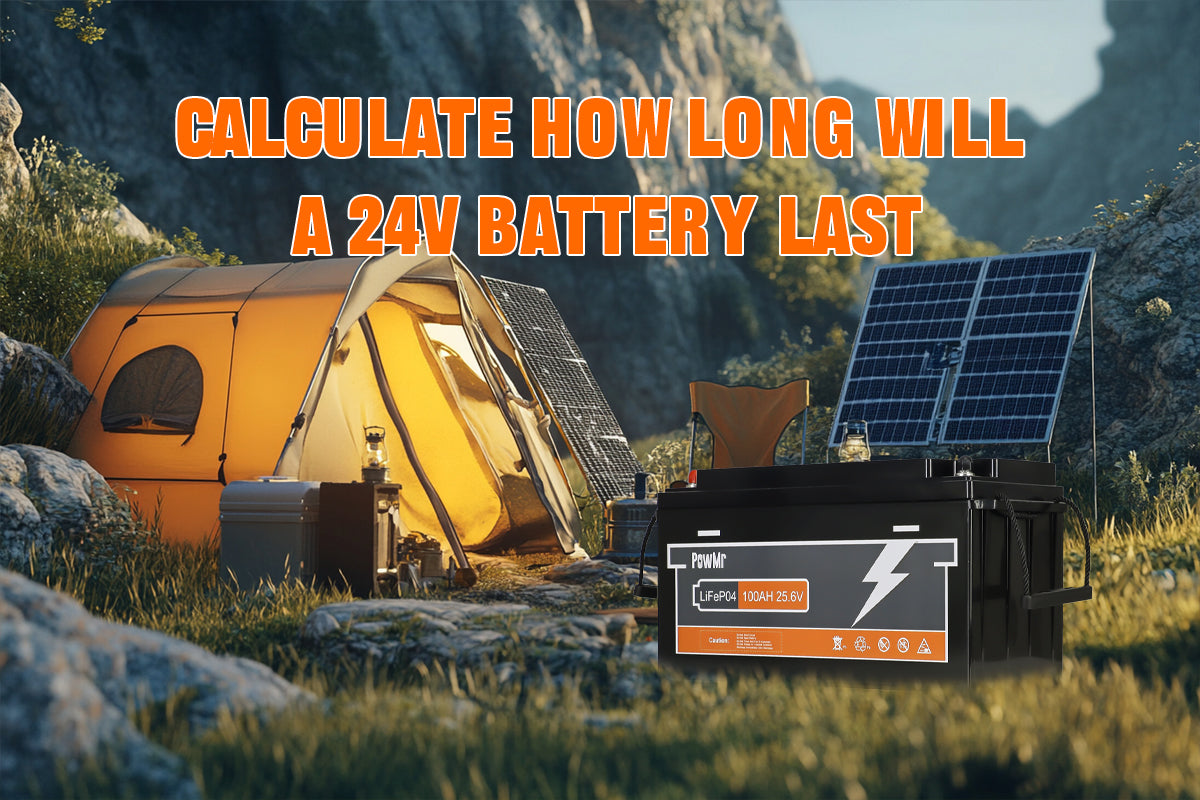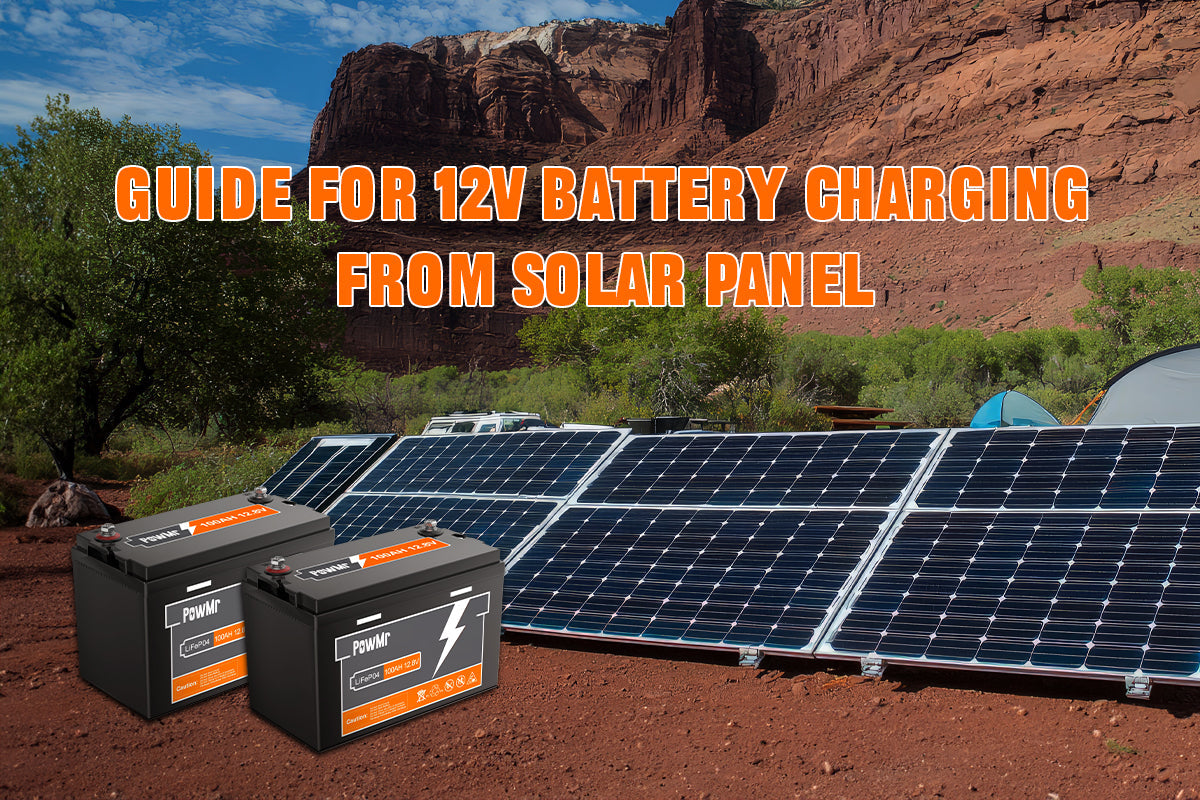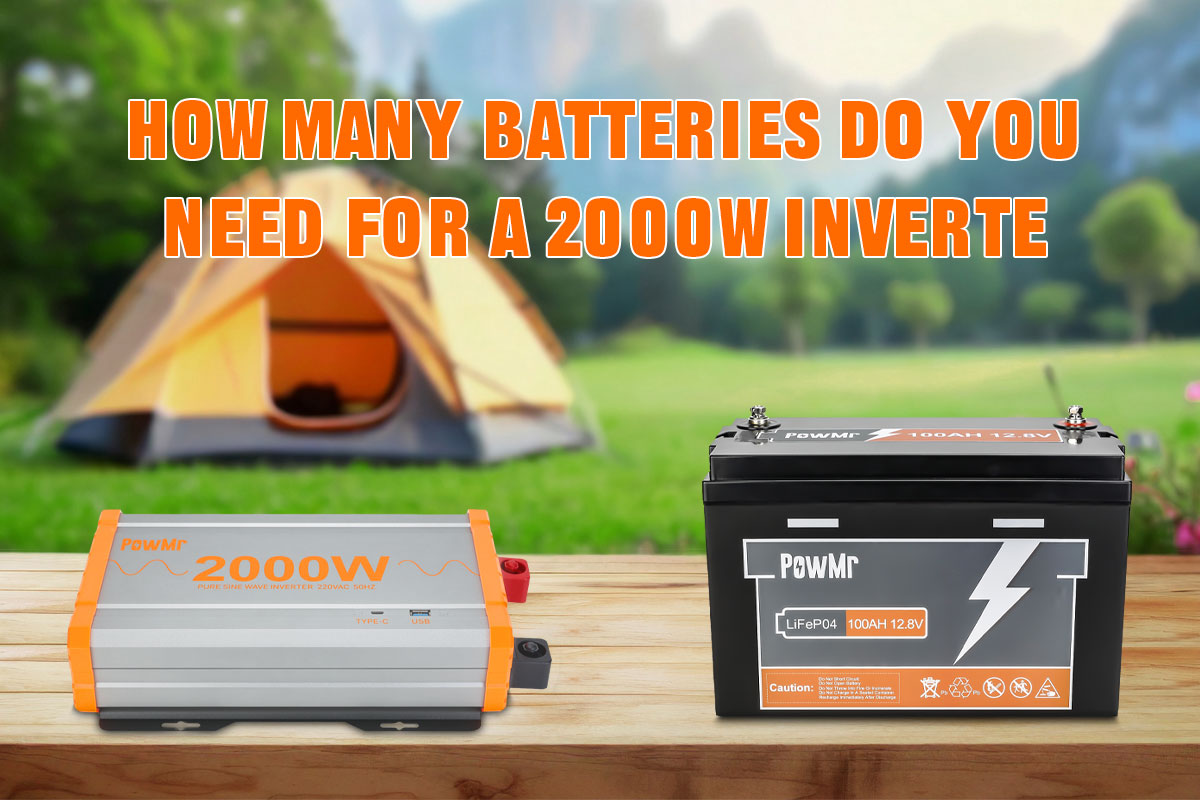เมื่อจัดตั้งระบบพลังงานแสงอาทิตย์ หนึ่งในแง่มุมที่สำคัญคือการเข้าใจว่าชุดแบตเตอรี่ของคุณจะใช้งานได้นานแค่ไหนก่อนที่จะต้องชาร์จใหม่ สำหรับระบบที่ทำงานที่ 24V ไม่ว่าคุณจะใช้ระบบสำรองขนาดเล็กหรือจ่ายไฟให้กับโหลดที่ใหญ่กว่า การคำนวณระยะเวลาการทำงานของแบตเตอรี่เป็นสิ่งจำเป็นสำหรับการวางแผนและประสิทธิภาพ
ในบล็อกนี้ เราจะสำรวจปัจจัยที่มีอิทธิพลต่อระยะเวลาการทำงานของแบตเตอรี่ 24V และให้สูตรที่ง่ายต่อการติดตามเพื่อประเมินว่าแบตเตอรี่ 24V จะใช้งานได้นานแค่ไหนกับการจัดอันดับความจุต่างๆ (เช่น 100Ah หรือ 200Ah) และกับอินเวอร์เตอร์.
วิธีการคำนวณระยะเวลาการใช้งานของแบตเตอรี่ 24v
ในการคำนวณว่าแบตเตอรี่ 24V จะใช้งานได้นานแค่ไหน เราสามารถใช้สูตรดังต่อไปนี้:
ระยะเวลาการใช้งานแบตเตอรี่ = ความจุแบตเตอรี่ (Ah) × แรงดันไฟฟ้าแบตเตอรี่ (V) × ประสิทธิภาพของอินเวอร์เตอร์ × DoD / การใช้พลังงาน (วัตต์)
ในสูตรนี้:
- ความจุแบตเตอรี่ (Ah) หมายถึงการจัดอันดับแอมป์-ชั่วโมงของแบตเตอรี่ ซึ่งบ่งบอกถึงกระแสไฟฟ้าที่สามารถจ่ายได้ในช่วงเวลา.
- แรงดันแบตเตอรี่ (V) หมายถึงระดับแรงดันไฟฟ้าที่คงที่ของแบตเตอรี่ เช่น 12V, 24V, หรือ 48V ในกรณีนี้คือ 24 โวลต์.
- การใช้พลังงาน (วัตต์) คือพลังงานรวมที่อุปกรณ์หรือเครื่องใช้ที่คุณกำลังใช้งานดึงออกมา.
- ประสิทธิภาพของอินเวอร์เตอร์ วัดว่ามันแปลงพลังงาน DC จากแบตเตอรี่หรือแผงโซลาร์เซลล์เป็นพลังงาน AC ที่ใช้งานได้อย่างมีประสิทธิภาพเพียงใด.
- Depth of Discharge (DoD) หมายถึง เปอร์เซ็นต์ของความจุของแบตเตอรี่ที่ถูกใช้งานแล้ว.
แบตเตอรี่ LiFePO4 ซึ่งใช้ในระบบพลังงานแสงอาทิตย์ ถูกออกแบบมาให้ทนต่อการปล่อยประจุลึกได้ดีกว่าแบตเตอรี่ประเภทอื่น เช่น แบตเตอรี่ตะกั่ว-กรด โดยทั่วไปสามารถรองรับการใช้งานได้ประมาณ 3,000 ถึง 5,000 รอบที่ระดับการปล่อยประจุ 80%.
นี่หมายความว่าการปล่อยให้แบตเตอรี่มีระดับต่ำกว่า 80% ของความจุเป็นประจำสามารถช่วยยืดอายุการใช้งานให้ยาวนานที่สุดเท่าที่จะเป็นไปได้.
เพื่อปกป้องอายุการใช้งานของแบตเตอรี่ แนะนำให้ใช้ DoD ที่ 50-80% เพื่อรักษาสมดุลระหว่างการเพิ่มพลังงานที่มีอยู่และการรักษาสุขภาพของแบตเตอรี่ในระยะยาว.
คู่มือที่เกี่ยวข้อง:
ตัวอย่างเช่น PowMr แบตเตอรี่ 24V LiFePO4 ที่แนะนำให้ใช้ DoD คือ 80% คุณจะต้องคูณความจุของแบตเตอรี่ด้วย 0.80 เพื่อประมาณการว่าคุณมีพลังงานที่ใช้งานได้เท่าไหร่.
แบตเตอรี่ 24V จะใช้งานได้นานแค่ไหนกับอินเวอร์เตอร์?
อินเวอร์เตอร์แปลงพลังงานไฟฟ้ากระแสตรงที่เก็บในแบตเตอรี่เป็นพลังงานไฟฟ้ากระแสสลับ ซึ่งเป็นสิ่งจำเป็นสำหรับเครื่องใช้ในบ้านส่วนใหญ่ เราสามารถสมมติได้ว่าเมื่ออินเวอร์เตอร์ ทำงานที่กำลังเต็ม กำลังที่ระบุจะเท่ากับการใช้พลังงาน ทำให้การคำนวณง่ายขึ้น.
ตัวอย่างเช่น มาดู PowMr อินเวอร์เตอร์ 1000W ซึ่งมีประสิทธิภาพ 94% ในการแปลงกระแส DC จากแบตเตอรี่ 24V.
ตอนนี้ มาสำรวจตัวอย่างที่ใช้ได้จริงโดยใช้ความจุแบตเตอรี่ทั่วไปสองประเภท:
แบตเตอรี่ 24V 100Ah จะอยู่ได้นานแค่ไหน?
สมมติว่าเรากำลังใช้แบตเตอรี่ PowMr 24V LiFePO4 ที่มีความจุ 100Ah และอินเวอร์เตอร์ PowMr ที่มีการจัดอันดับที่ 1000W โดยมีประสิทธิภาพ 94% ความลึกของการปล่อย (DoD) ที่แนะนำสำหรับแบตเตอรี่นี้คือ 80% ซึ่งหมายความว่าเราจะใช้ 80% ของความจุรวมของแบตเตอรี่เพื่อยืดอายุการใช้งานของมัน.
การนำค่าดังกล่าวไปใช้ในสูตรที่กล่าวถึงก่อนหน้านี้:
- ระยะเวลาการใช้งานแบตเตอรี่ = 100Ah * 24V * 0.94 * 0.80 / 1000W
ดังนั้น แบตเตอรี่ 24V 100Ah จะใช้งานได้นาน 1.8 ชั่วโมง ในการจ่ายไฟให้กับโหลด 1000W ผ่านอินเวอร์เตอร์ที่มีประสิทธิภาพ 94% ระยะเวลาการใช้งานนี้อาจเปลี่ยนแปลงได้ตามการใช้พลังงานจริงของอุปกรณ์ของคุณและประสิทธิภาพของอินเวอร์เตอร์.
แบตเตอรี่ 24V 200Ah จะอยู่ได้นานแค่ไหน?
ใช้วิธีการเดียวกันนี้ เราสามารถคำนวณระยะเวลาการทำงานสำหรับแบตเตอรี่ขนาดใหญ่ 24V 200Ah ได้อีกครั้ง โดยเราจะสมมติว่าใช้ PowMr 1000W อินเวอร์เตอร์ที่มีประสิทธิภาพ 94% และระดับการปล่อยพลังงาน (DoD) ที่ 80%.
- ระยะเวลาการใช้งานแบตเตอรี่ = 200Ah * 24V * 0.94 * 0.80 / 1000W ≈ 3.6 ชั่วโมง
ดังนั้น แบตเตอรี่ 24V 200Ah จะใช้งานได้นานประมาณ 3.6 ชั่วโมง กับอินเวอร์เตอร์ 1000w.
ปัจจัยอื่น ๆ ที่มีผลต่อระยะเวลาการทำงานของแบตเตอรี่
แม้ว่าการคำนวณข้างต้นจะให้การประมาณการเวลาการทำงานของแบตเตอรี่ที่มั่นคง แต่ยังมีปัจจัยอื่น ๆ ที่สามารถมีอิทธิพลต่อประสิทธิภาพจริง:
ประเภทแบตเตอรี่:
แบตเตอรี่เคมีที่แตกต่างกัน (เช่น แบตเตอรี่ตะกั่ว-กรด, AGM หรือ LiFePO4) มีลักษณะการปล่อยประจุและความทนทานที่แตกต่างกัน แบตเตอรี่ลิเธียม ตัวอย่างเช่น สามารถปล่อยประจุได้ลึกกว่าตะกั่ว-กรดโดยไม่เกิดความเสียหาย ซึ่งมีผลต่อระยะเวลาการใช้งาน.
อายุแบตเตอรี่:
เมื่อเวลาผ่านไป แบตเตอรี่ทั้งหมดจะสูญเสียความจุเนื่องจากการเสื่อมสภาพตามธรรมชาติ แบตเตอรี่ใหม่เอี่ยมจะทำงานได้ดีกว่าแบตเตอรี่ที่ถูกใช้งานไปหลายร้อยครั้ง.
อุณหภูมิ:
อุณหภูมิที่รุนแรง (ทั้งร้อนและเย็น) สามารถลดความจุที่มีประสิทธิภาพของแบตเตอรี่และส่งผลต่อระยะเวลาที่มันสามารถจ่ายพลังงานได้.
ความแปรปรวนของโหลด:
การประมาณเวลาการทำงานข้างต้นถือว่ามีภาระคงที่ ในการใช้งานจริง ภาระอาจเปลี่ยนแปลงตลอดทั้งวัน ซึ่งส่งผลต่อประสิทธิภาพของแบตเตอรี่โดยรวม.
บทสรุป
การคำนวณว่าแบตเตอรี่ 24V จะใช้งานได้นานแค่ไหนขึ้นอยู่กับการเข้าใจการใช้พลังงานของคุณและความจุของแบตเตอรี่
โปรดทราบว่าประสิทธิภาพในโลกจริงอาจแตกต่างกันไปตามปัจจัยต่างๆ เช่น ประเภทแบตเตอรี่ อายุ และสภาพแวดล้อม.
การเข้าใจความสามารถของแบตเตอรี่ของคุณช่วยให้คุณวางแผนระบบพลังงานแสงอาทิตย์หรือโซลูชันสำรองได้ดียิ่งขึ้น โดยมั่นใจว่าคุณมีพลังงานที่เก็บไว้เพียงพอเพื่อตอบสนองความต้องการของคุณ.



